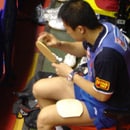In September 2008 the ITTF will ban all speed glues which contain toxic solvents. Not everybody is happy with this plan of action. Speed glues have been used to improve overall play in tournaments. I agree with them on banning speed glues.
Where is speed glue originated from?
Speed glue was discovered in the ’70s when a table tennis player used bicycle puncture repair glue to repair his racket when the

The difference in playing became obvious. However, this high-performance effect only lasted for a few hours after playing with it. Speed glue really became popular when player Dragutin Šurbek from Yugoslavia used it from 1979 till 1983 helped him to improve his overall gameplay.
Since then, the whole world is using speed glue to increase the amount of speed and spin, especially in the higher classes and at the international level. Everybody is gluing
Shorter rallies for the game
In the heydays of table tennis, professional players used to be older than 30 years with tons of experience before really getting to the top of the world.
Nowadays, young players of 16 years can make it to the top by fast ‘labomba’ play and training every day. I agree with the plans of the ITTF (international table tennis federation) on banning speed glue.
Toxic chemicals found in speed glue
The main reason behind this plan of action is that there are toxic chemicals in the speed glue that can cause cancer and other diseases. When you glue twice a week it is a problem for your health.
If you have been playing since you were ten years old, train 5 (or more) times a week, and glue multiple times a day, then this could become a serious issue.
Like Dr. Jean-François Kahn said in an interview: “As a doctor and as a member of different national and international sports bodies (French TTA, ETTU, ITTF) I feel responsible for the health of our players and of other people concerned with table tennis, and I am convinced that the situation existing for over fifteen years is not the best one”.
The decision taken in the early nineties to limit the concentration of some organic solvents (aromatic and chlorinated solvents) is excellent. Although, players and coaches can make themselves mixtures with different so-called “more or less harmful” glues and solvents. Today, despite a large number of commercial advertisements, there is not a single “clean” glue on the market.”
Aside from the health risks, the speed of production is also increasing. New and faster
Glue is the cause of the tremendous speed. Even a rather slow all-round racket can become deadly fast with a few layers of glue. Professional players usually use up to 5 layers of glue.
As mentioned earlier, because of this increasing speed the sport is getting harder to follow for spectators. Rallies are getting shorter, while long rallies are slowly becoming rare. On the other hand, 16-year-old players can make it to the top of the world with their fast, close-by-the-table style of play.
Camera angles are no longer interesting. The view from behind/above the table will make it look slower and easier than it is. Then when filming at table-height it will be too fast to follow. Since the sport is fast the number of defenders in the top 100 of the world is very little.
Only about 7 defensive players can still compete with offensive players of that class. While matches of a defender vs. an attacker are the most spectacular to watch.
Is there an alternative? The speed and spin that speed glue gives will not be feasible anymore once the glue is banned. However, most table tennis brands are already researching and developing new build-in-speed glue effect technologies comprehensively.
The company Butterfly, for instance, has the ‘power-sponge’ rubbers and Joola the ‘Energy Green Power’
When speed glue with toxic solvents is banned. tt-brands will continue researching and developing new
Eventually, this ban will also save you some money! Because having to buy 2x Bryce and Fair-chack glue every 3/4 months is more expensive than 2x Bryce Power sponge every 3/4 months.
I hope it was helpful and interesting to you all.
Related post:

Warren Davies
Hi, I’m Warren Davies, a table tennis addict who loves sharing tips, reviews, and everything you need to level up your game. I’ve spent years playing, testing gear, and geeking out over the sport, and I’m here to make things simple and fun for players of all levels. When I’m not writing, you’ll probably find me perfecting my forehand or trying out the latest paddle.









3 thoughts on “Banning Speed Glue”
On the one hand I can’t imagine the time, when that regulation will enter into force on. And not only me, but all those players out there, who use speed glue every training and match.
Definitely those times will be easier for most of the defenders hehe
However slower game will be less spectacular … at least for me
On the other hand it’s good, I mean for our health of course.
But hey if they wanted to ban speed glue, why they haven’t done it a long time ago. They knew how much toxic they are O.o
Anyway I hope that all those table tennis brands will develop less toxic glues or like it’s written in the article “bulit-in speed glue effect technologies”. So we still be able to enjoy that sport like we are now.
This won’t affect me but will affect tons of others and they will not be happy but for the future of table tennis this is for the best and will definitely bring out the best players out there.
thats bull… forbidden glues are less toxic that some legal glues